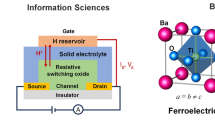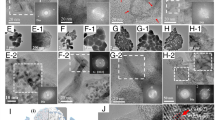Abstract
Point defects in diamond such as vacancies act as a strong donor compensation center; therefore, remarkably reduce electron conductivity of diamond-based devices. Artificial synthesis methods of n-type diamond utilize the hydrogen-containing precursors enabling its diffusion into diamond crystal and subsequent formation of hydrogen-vacancy complexes. Here we employ spin-polarized, hybrid density functional theory calculations, in order to characterize the electronic properties and stability of hydrogen-passivated vacancies in diamond. We found strong thermodynamic preference for hydrogen passivation of four vacancy-related dangling bonds. An analysis of formation energy vs Fermi level diagrams indicate, that strong donor compensation effect associated with vacancies can be entirely neutralized by hydrogen incorporation. Thus, a careful control of hydrogen partial pressure in the growth process might be crucial to improve the electron conductivity of n-type diamond.
Similar content being viewed by others
References
J. Isberg, J. Hammersberg, E. Johansson, T. Wikström, D.J. Twitchen, A.J. Whitehead, S.E. Coe, G.A. Scarsbrook, Science 297, 1670 (2002).
A.T. Collins, Properties and Growth of Diamond, (INSPEC, London, 1994).
J.P. Goss, J. Phys. Condens. Matter. 15, R551 (2003).
T.L. Estle, S. Estreicher, D.S. Marynick, Phys. Rev. Lett. 58, 1547 (1987).
P. Briddon, R. Jones, G.M.S. Lister, J. Phys. C Solid State Phys. 21, L1027 (1988).
N. Sahoo, S.K. Mishra, K.C. Mishra, A. Coker, T.P. Das, C.K. Mitra, L.C. Snyder, A. Glodeanu, Phys. Rev. Lett. 50, 913 (1983).
D. Saada, J. Adler, R. Kalish, Phys. Rev. B. 61, 10711 (2000).
A. Upadhyay, A.K. Singh, A. Kumar, Comput. Mater. Sci. 89, 257 (2014).
S. Estreicher, A.K. Ray, J.L. Fry, D.S. Marynick, Phys. Rev. B. 34, 6071 (1986).
H. Tachikawa, Chem. Phys. Lett. 513, 94 (2011).
T. Claxton, A. Evans, M. Symons, J. Chem. Soc. Faraday Trans. 2. 82, 2031 (1986).
C.P. Herrero, R. Ramírez, Phys. Rev. Lett. 99 (2007).
T. Nishimatsu, H. Katayama-Yoshida, N. Orita, Phys. B Condens. Matter 302–303, 149 (2001).
A.B. Anderson, L.N. Kostadinov, J.C. Angus , Phys. Rev. B. 67, 1 (2003).
C.P. Herrero, R. Ramírez, E.R. Hernández, Phys. Rev. B. 73, 245211 (2006).
G. Thiering, A. Gali, Phys. Rev. B. 92, 165203 (2015).
G. Thiering, A. Gali, Phys. Rev. B. 94, 125202 (2016).
P.E. Blöchl, Phys. Rev. B. 50, 17953 (1994).
G. Kresse, J. Furthmüller, Phys. Rev. B. 54, 11169 (1996).
J. Heyd, G.E. Scuseria, M. Ernzerhof, J. Chem. Phys. 118, 8207 (2003).
J. Heyd, G.E. Scuseria, M. Ernzerhof, Erratum: “Hybrid functionals based on a screened Coulomb potential” [J. Chem. Phys. 118, 8207 (2003)]. J. Chem. Phys. 124, 219906 (2006).
S. Lany, A. Zunger, Phys. Rev. B 80, 085202 (2009).
P. Deák, A. Gali, B. Aradi, T. Frauenheim, Phys. Status Solidi Basic Res. 248, 790 (2011).
K. Czelej, P. Śpiewak, K.J. Kurzydłowski, MRS Adv. 1, 1093 (2016).
P. Śpiewak, K.J. Kurzydłowski, Phys. Rev. B 88, 195204 (2013).
P. Śpiewak, J. Vanhellemont, K.J. Kurzydłowski, J. Appl. Phys. 110, 063534 (2011).
H. Monkhorst, J. Pack, Phys. Rev. B. 13, 5188 (1976).
Y. Xiao, Z. Wei, Z. Wang, Comput. Math. with Appl. 56, 1001 (2008).
S. Lany, A. Zunger, Phys. Rev. B. 78, 235104 (2008).
Author information
Authors and Affiliations
Rights and permissions
About this article
Cite this article
Czelej, K., Śpiewak, P. Hydrogen passivation of vacancies in diamond: Electronic structure and stability from ab initio calculations. MRS Advances 2, 309–314 (2017). https://doi.org/10.1557/adv.2017.100
Published:
Issue Date:
DOI: https://doi.org/10.1557/adv.2017.100




